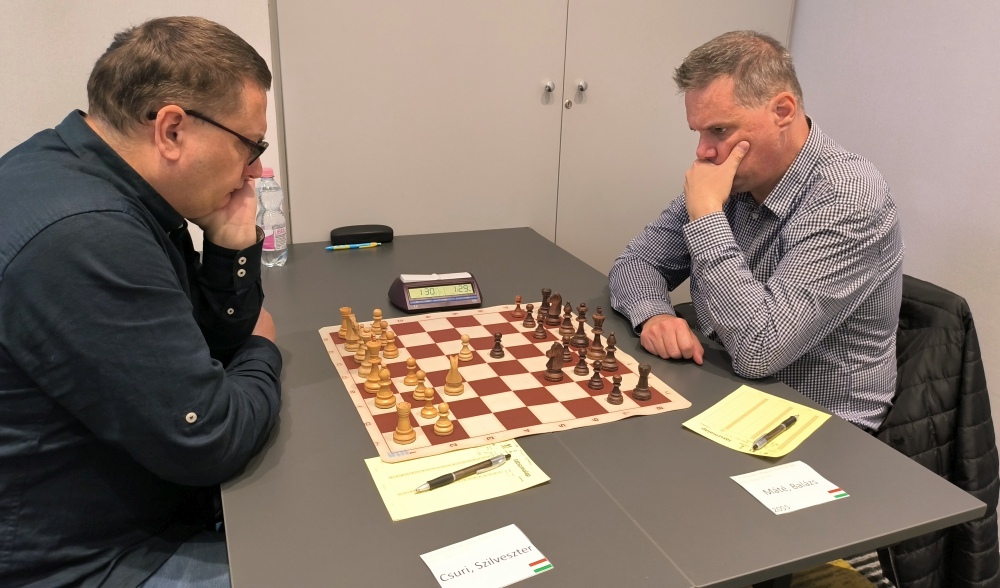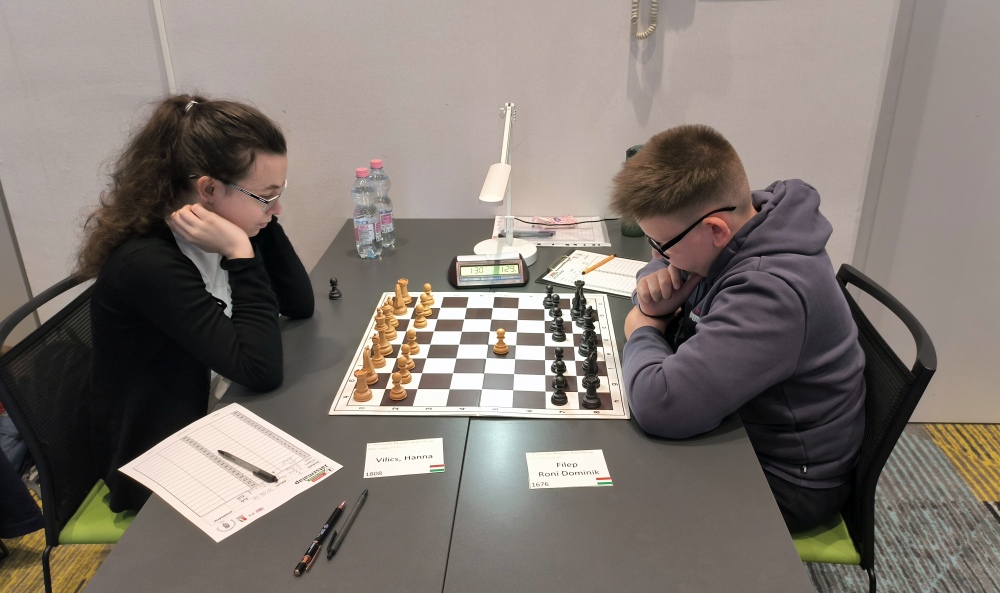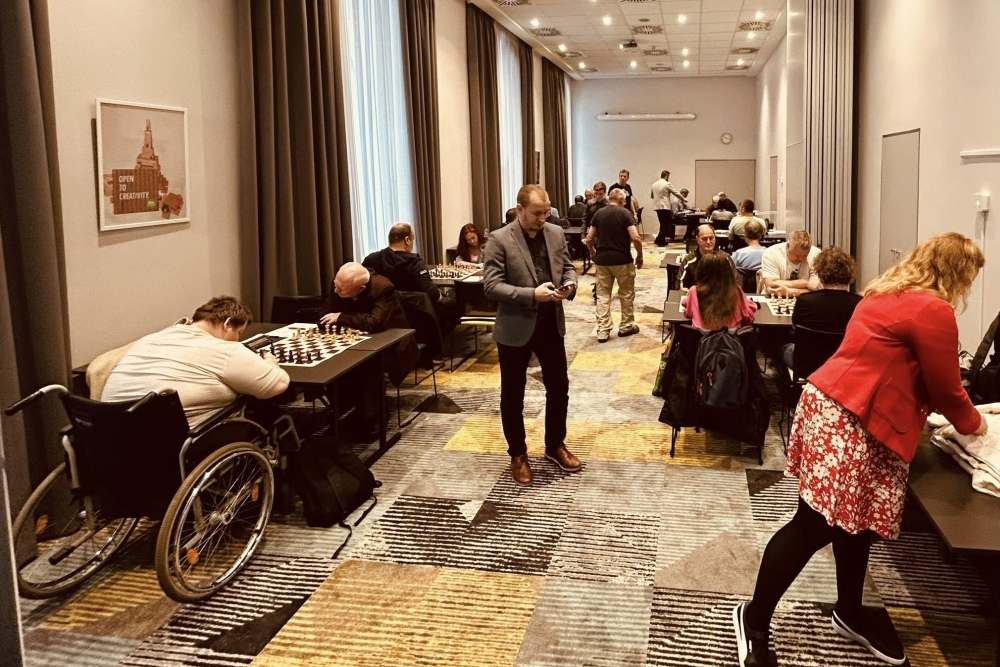Written by IA Robert Kapas
Jointly organized by the Hungarian Chess Federation, FODISZ (the organization for sports of persons with disabilities) and the Hungarian Paralympic Committee, the fifth edition of the Hungarian Parachess Championship took place from May 22–25. This is a unique national individual championship, bringing together players who are visually impaired, hearing impaired, physically disabled and organ transplant recipients.
 In this video course, experts (Pelletier, Marin, Müller and Reeh) examine the games of Judit Polgar. Let them show you which openings Polgar chose to play, where her strength in middlegames were, or how she outplayed her opponents in the endgame.
In this video course, experts (Pelletier, Marin, Müller and Reeh) examine the games of Judit Polgar. Let them show you which openings Polgar chose to play, where her strength in middlegames were, or how she outplayed her opponents in the endgame.The visually impaired mostly play two-board chess - a special format also used internationally - where each player moves both sides on their own board, announcing moves aloud, so both competitors can comfortably think about their next steps without disturbing each other. This setup requires extra attention, as communication between hearing impaired and visually impaired players can sometimes be challenging. Fortunately, the dedicated arbiters are always on hand to assist, and the exceptional sportsmanship shown by participants ensures the smooth running of the tournament.

It is truly commendable that these three organizations continue to join forces year after year to champion the cause of parachess. Beyond highlighting how universal, inclusive, and open chess is, this event also fosters a sense of community in what is traditionally an individual sport. It provides opportunities for players whose ability to compete among able-bodied participants is sometimes limited by technical barriers, and helps them prepare for international tournaments.
This year's championship not only drew a record number of participants - 24 players may not seem like many, but in a small country, especially within the disabled community, it is significant - but also delivered plenty of excitement. Going into the final rounds, four players had a chance at the overall gold medal, which was ultimately claimed by the rating favourite, FM Zoltán Zambó.

In the visually impaired category, Zoltán Zambó took first place, ahead of Szilveszter Csuri, who had an excellent debut, and István Voján, a longtime team member returning to form. Among the hearing impaired, Balázs Máté (pictured above, right) claimed victory, followed by Tibor Hallossy and Virág Farkas on the podium. In the physically disabled category, László Lengyel, who played on board one in the final round, emerged victorious, with Péter Turoczi finishing second.
Notably, Virág Farkas was recognized as both the best young player and the top female competitor, delivering a consistent performance and finishing an excellent 8th overall. The youngest participant, 14-year-old visually impaired talent Roni Dominik Filep (pictured below, right), took second place in the youth category, showing impressive combinational skills in the final round by defeating Hanna Vilics (pictured below, right), the only youth member of Hungary's national visually impaired team.
 In this DVD, Erwin l'Ami guides you through the fascinating Benko Gambit. As early as move three Black starts a fight for the initiative, a strategy that has proved to be successful in countless amateur and master level games.
In this DVD, Erwin l'Ami guides you through the fascinating Benko Gambit. As early as move three Black starts a fight for the initiative, a strategy that has proved to be successful in countless amateur and master level games.
We would be delighted if other countries joined this initiative so that chess players with various disabilities can participate together in the Hungarian Championship, which is planned to be an open tournament.
Federations interested in sending players are encouraged to contact us at chess@chess.hu, so we can gauge international interest and explore expanding the competition to a broader level. We firmly believe that chess for people with disabilities deserves great attention and support.
Final standings
| 1 |
1 |
|
FM |
Zambo, Zoltan Istvan |
|
HUN |
2291 |
5,5 |
28 |
0 |
20,5 |
| 2 |
6 |
|
|
Csuri, Szilveszter |
|
HUN |
1960 |
5 |
29,5 |
0 |
21 |
| 3 |
2 |
|
|
Mate, Balazs |
|
HUN |
2055 |
4,5 |
29 |
0 |
19,5 |
| 4 |
12 |
|
|
Vojan, Istvan |
|
HUN |
1813 |
4,5 |
27 |
0 |
19 |
| 5 |
3 |
|
|
Lengyel, Laszlo |
|
HUN |
2006 |
4 |
29,5 |
0 |
19 |
| 6 |
14 |
|
|
Feher, Laszlo |
|
HUN |
1792 |
4 |
27,5 |
0 |
15 |
| 7 |
7 |
|
|
Hallossy, Tibor |
|
HUN |
1942 |
4 |
26,5 |
0 |
17,5 |
| 8 |
16 |
|
|
Farkas, Virag |
w |
HUN |
1747 |
4 |
26,5 |
0 |
16,5 |
| 9 |
4 |
|
|
Elo, Istvan |
|
HUN |
1980 |
4 |
25 |
0 |
14,5 |
| 10 |
11 |
|
|
Rev, Miklos |
|
HUN |
1833 |
4 |
22 |
0 |
15 |
| 11 |
21 |
|
|
Filep, Roni Dominik |
|
HUN |
1676 |
4 |
19,5 |
0 |
10 |
| 12 |
9 |
|
|
Raibl, Zoltan |
|
HUN |
1919 |
3,5 |
28,5 |
0 |
17 |
| 13 |
10 |
|
|
Szentgyorgyi, Sandor |
|
HUN |
1853 |
3,5 |
22,5 |
0 |
14,5 |
| 14 |
5 |
|
|
Bokros, Istvan |
|
HUN |
1975 |
3,5 |
20,5 |
0 |
12,5 |
| 15 |
13 |
|
|
Vilics, Hanna |
w |
HUN |
1808 |
3 |
28 |
0 |
13,5 |
...24 players
Vilics 0-1 Filep (a fine attacking victory)
Links


























